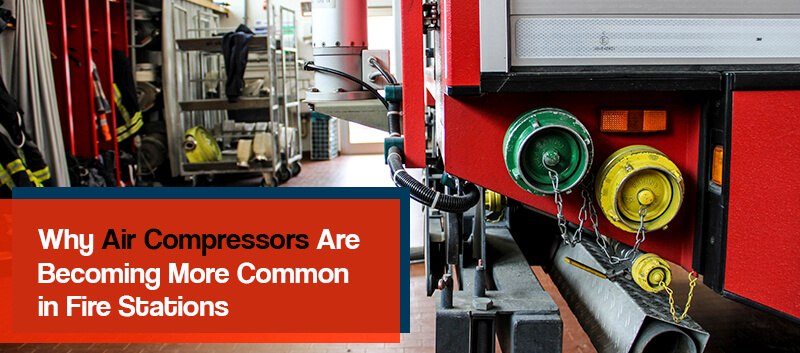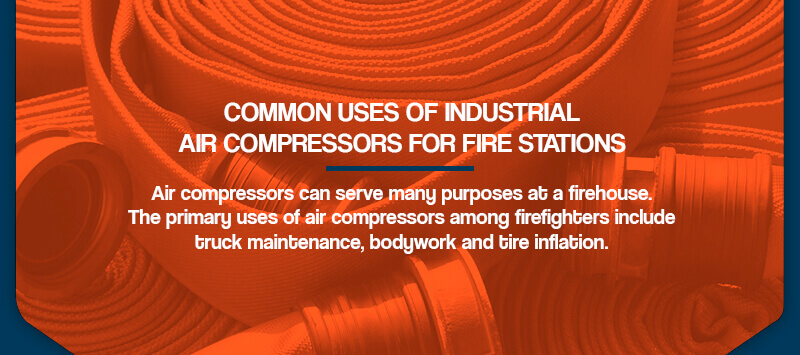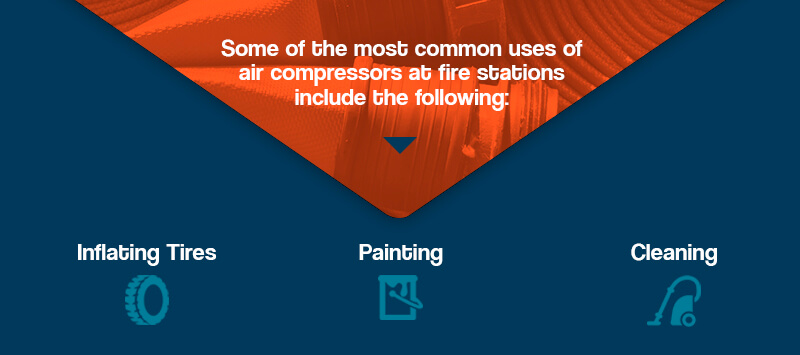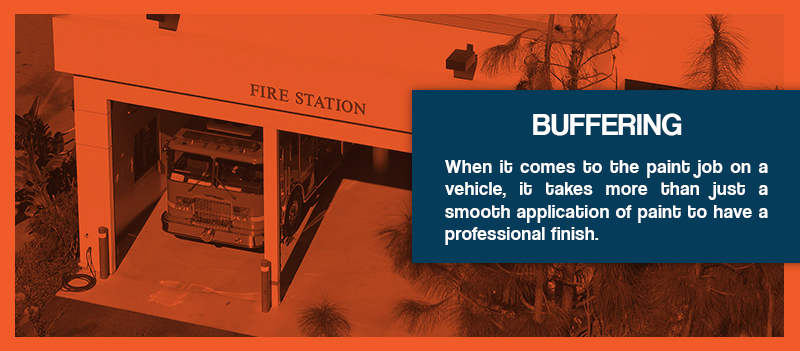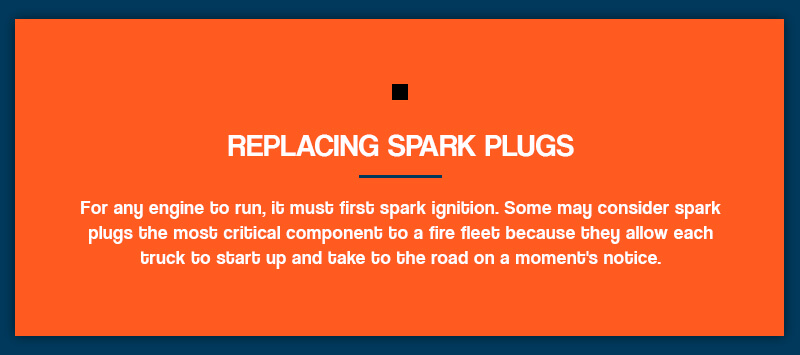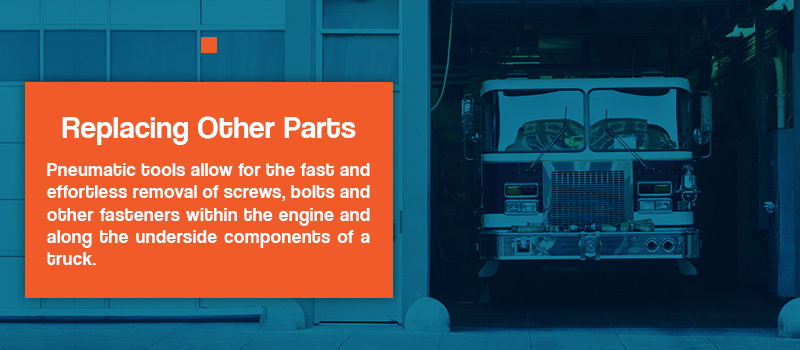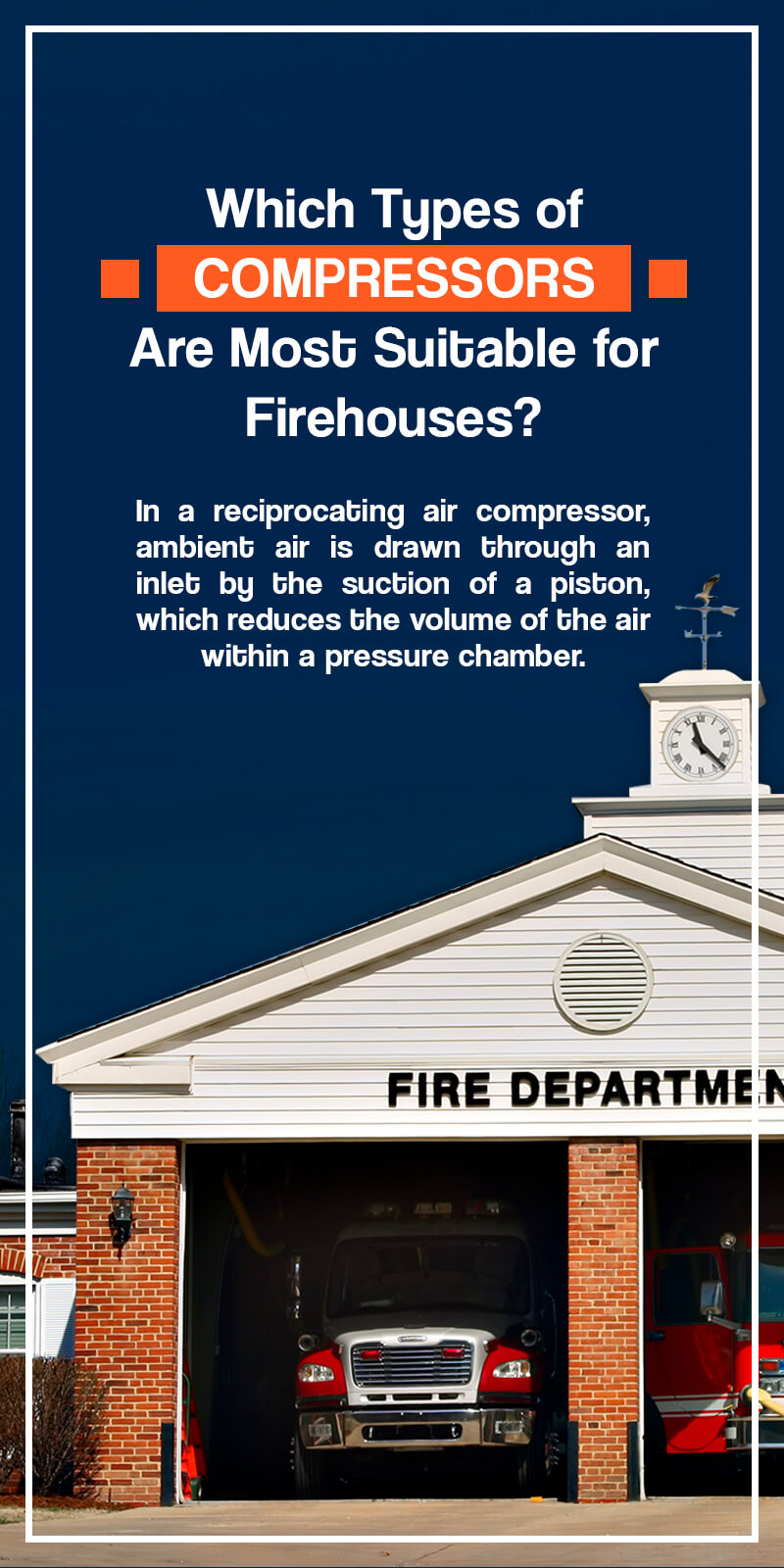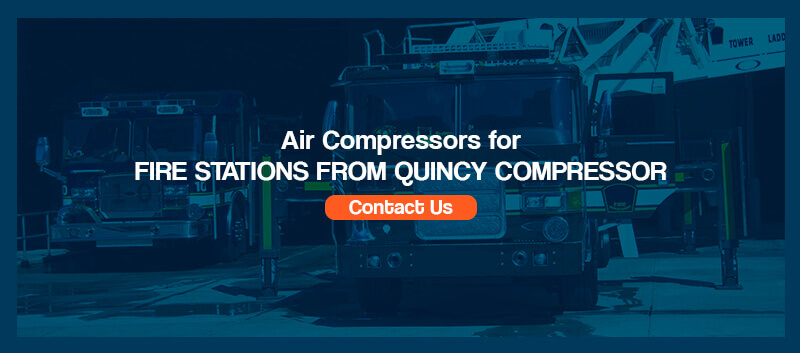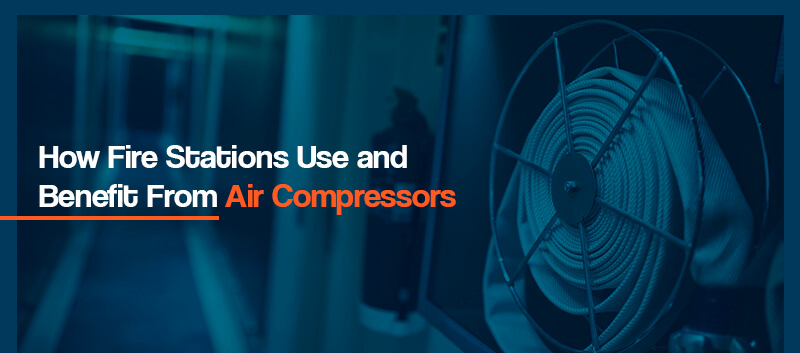
As growing numbers of public- and private-sector entities seek to trim their expenses, organizations are embracing ways to perform secondary functions with reduced reliance on third parties. For example, many organizations now handle maintenance tasks in-house where previously they would have lacked the necessary capabilities. Today, companies can save money by having employees take on additional responsibilities that would have once been outsourced to totally different trades.
Air compressors have grown in popularity in recent years because of the many capabilities afforded by pressurized air power. Throughout the industrial, military, medical and public service sectors, many companies have harnessed air power as a superior alternative to electronic and manual functions. The expanded popularity of air compressors has fueled a boom in the market, which is expected to hit $34.87 billion by 2021.
The trend can be observed among fire stations, which have harnessed the power of air compressors to perform certain maintenance tasks that would have once required third-party service crews. Firefighters use air compressors to facilitate in-house truck repairs and maintenance. With the proper air-powered tools, firefighters can now be their own truck mechanics.
Why Air Compressors Are Becoming More Common in Fire Stations
Like any public or private body that uses large vehicles, fire stations had long relied on manual tools for basic maintenance tasks. Trouble was, these tools could only do so much. The tasks required would involve tremendous physical exertion that could leave firefighters — the same people who could be called to action at a moment’s notice — strained and sore in all the wrong places. Inevitably, fire stations would often have to turn their trucks over to third-party repair shops for many common maintenance tasks.
With air compressors on hand, firefighters can reduce trips to service shops and handle many repair and maintenance tasks in-house. Rotary screw air compressors and reciprocating compressors can be used to power a wide range of tools. These tools can turn physically demanding and lengthy processes into simple jobs in just a fraction of the time that would otherwise be required.
So what are the best air compressors for firefighters? Overall, air compressors typically come in two types — reciprocating and rotary screw. The best kind depends on the demands of the tasks at hand. If you simply wish to change out engine parts, you will need a compressor with sufficient pressure, measured in pounds per square inch (PSI), to operate a pneumatic socket wrench and other necessary air tools. If you wish to paint the body of a fire truck, you will need a compressor designed to run continuously. Overall, the best air compressor for a fire station will have the capacity for the full range of applicable tasks.
Common Uses of Industrial Air Compressors for Fire Stations
Air compressors can serve many purposes at a firehouse. The primary uses of air compressors among firefighters include truck maintenance, bodywork and tire inflation.
There are many reasons why station crews prefer air-powered tools over manual and electrically-powered ones. For starters, pneumatic tools are easier to handle because the air power itself does most of the work. When it comes to sanding surfaces and removing fasteners, you only need to apply the tool to the vehicle part in need of maintenance. There is hardly any physical exertion required to operate pneumatic tools, which perform so fast that there is little possibility for human error.
Make sure you have an air compressor that can deliver the necessary PSI for the tools at hand. If, for example, you buy a compressor that only delivers up to 90 PSI, yet your pneumatic tools need 110 PSI to function properly, your compressor will be inadequate.
Some of the most common uses of air compressors at fire stations include the following:
1. Inflating Tires
One of the critical reasons for a firehouse to have an air compressor is tire inflation. During each inspection of the trucks in your fleet, take note of the pressure of each tire on every vehicle. If one of the trucks lacks sufficient tire pressure, it could endanger the fire crew as well as fellow motorists along a given roadway. The stakes are even higher when a truck is responding to an emergency call. Even if only one tire is inadequately pumped, it could leave the truck with an imbalance as it speeds along boulevards and highways.
For the trucks in a fire fleet to be safe for the roads, each fire station should be equipped with a rotary screw compressor or a reciprocating compressor that can inflate tires as needed.
2. Painting
One of the most distinguishing characteristics of a fire truck is its paint job. The fact that the term “fire engine red” has become part of the color lexicon is a testament to the iconic role that fire trucks serve in every community. To that end, it is important to keep all the trucks in your fleet looking immaculate, starting with the first thing everyone will notice — the red body paint.
When you paint the body of a vehicle, it is crucial to ensure that no oil, watery mist or dust particles get into the spray coat. It is also crucial for the paint coats to go on evenly without blotches, drips or weak spots. To ensure that each coat of paint is applied successfully, you will need to have a quality air compressor with the right pneumatic spray tools.
With an oil-free, air-powered spray painter, you can apply coats of red paint on fire trucks with the evenness, luster and shine of sporty vehicles. Pneumatic spray painters also make it possible to do smooth, seamless touchups over paint cracks. Spray tools can be attached to reciprocating and rotary screw air compressors.
3. Buffering
When it comes to the paint job on a vehicle, it takes more than just a smooth application of paint to have a professional finish. For the trucks in your fleet to have the sleek, shiny red finish that everyone recognizes and loves about fire engines, each paint job needs to be finished off with a smooth, even buffering.
As with other vehicular work, the task of buffering can be quite labor intensive if you lack the proper tools. If you try to buff the body of a truck with manual tools, you are liable to wear out your arm in the process. Moreover, the finish of the paint job itself would not have the smoothness and shine that it could otherwise have if you instead use an air-powered buffer.
With a rotary or reciprocating air compressor on hand at your fire station, you can attach pneumatic buffing tools that are capable of finishing each paint job with a sleek finish that could shine as far as the eye can see. Air-powered buffing tools are also easy to operate because the task is performed by the power of the pressurized air. All you need to do is gently guide the tool along the painted body of each truck to achieve a professional shine.
4. Sanding
A fire truck will likely go through several paint jobs in its lifetime. Whether you decide to repaint the trucks in your fleet at two-year or four-year intervals — or in some cases, whenever a truck incurs bodily damage — you will need to strip the older paint to make way for the new coats. It is important to have efficient tools for sanding.
Granted, the task of sanding the body of a truck can be time-consuming and labor-intensive. As with buffering, sanding should be done with air-powered tools, as these are designed to strip away paint coats smoothly and evenly with minimal effort on your part. With a reciprocating or rotary screw air compressor, you can attach pneumatic sanding tools that will strip away paint in a matter of minutes, as opposed to the hours it could take to do the task manually with a sand block.
Once you have stripped away the old coat of paint, the body of the truck will be ready for the primer and new coat of red paint, all of which can easily be applied with air-powered sanders and paint sprayers. Best of all, these tasks can be performed with little risk of damage to the truck and in only a fraction of the time it would take with blocks and aerosol spray cans.
5. Cleaning
Despite the rough situations that a fire truck and its crew will often attend, a fire truck should always leave the station looking immaculate. Therefore, on a regular basis, each truck in your fleet should undergo a thorough external cleaning. Given the large areas that need to be cleaned, you can save time and ease on the labor involved by using pneumatic cleaning tools.
With a reciprocating or rotary screw air compressor, you can power pneumatic washers and blowers that will clean each truck from front to back and side-to-side within a matter of minutes. In fact, with the ease and efficiency that air-powered tools allow for such tasks, your crew may be more likely to clean each truck on a more frequent basis.
Pneumatic cleaning tools also make it easier to clear away dirt, oil and grime from engine and underside components. On the spinning parts of a truck, for example, it can often be hard to reach all of the grooves and crevices. With air-powered cleaning tools, you can blow away dirt that would be difficult, if not impossible, to remove manually, and this can all be done by simply holding the tool in front of the part in question and allowing the pressurized air to work its magic.
6. Replacing Spark Plugs
For any engine to run, it must first spark ignition. Some may consider spark plugs the most critical component to a fire fleet because they allow each truck to start up and take to the road on a moment’s notice. Without ignition, your crew would not be able to respond to emergency calls. Spark plugs, by extension, save property and lives from the deadly, destructive horrors of fire.
With air-powered maintenance tools, the task of replacing spark plugs is rendered easier and more efficient. Unlike manual tools, which can be challenging to work, pneumatic tools make it easy to remove old parts and install replacements in seconds flat. Even if an old spark plug is screwed in too tight, an air-powered screw tool will usually dislodge the stubborn piece almost instantly with no physical exertion on your part.
When you power up a pneumatic socket wrench with a reciprocating or rotary screw air compressor, all that you really must do is put on protective lenses, remove the wiring and apply the tool on the part that needs replacing. You can also take an air-powered cleaning tool to clear away any possible dirt or grime buildup. Then you simply use the same socket tool to put the new spark plugs into place and the task is done. Now your truck will be ready to respond instantly when the next emergency call comes.
7. Replacing Other Parts
Air compressors make it easier to perform a range of vehicular maintenance tasks. Pneumatic tools allow for the fast and effortless removal of screws, bolts and other fasteners within the engine and along the underside components of a truck. With a rotary screw or reciprocating air compressor at hand, your crew could easily perform many truck maintenance tasks in-house and drastically reduce your fleet’s number of visits to repair stations.
Consider all the parts of a fire truck that might need to be replaced in the course of a year. At any given time, one of the headlights, rear lights or emergency flashers could burn out on a given truck. With an air-powered screw or socket wrench, you could have the light assembly dislodged and traded out within a matter of minutes, if not seconds.
Consider also the parts along the bottom of a truck that could need adjustments, tightening or replacing during a given round of maintenance. With pneumatic tools, you could remove, replace or simply tighten hubcaps with minimal exertion, even in cases where the old fasteners have been locked into place by rust or the effects of extreme temperatures. These and other air-powered tools can help you adjust a fire truck’s rear suspension and even modify or replace the leaf springs.
8. Removing Rust
One of the most dangerous developments that could possibly take root on a fire truck is rust, which can spread quickly across exposed metal surfaces. Once rust takes hold in a given spot, it can spread rapidly to neighboring areas and even transfer to adjoined components.
On a fire truck, some of the most vulnerable areas for rust include the engine components, wheels, axles, leaf springs and chassis. Rust can even take root on the body of a fire truck if the metal is exposed in any spot due to a crack in the paint, which generally serves as a protective barrier against corrosive agents. If a metal spot becomes too saturated with rust, a hole could burn through the affected surface.
With air-powered sanding tools, you can rub away rust from the external, internal and underside parts of a truck before such problems get out of hand. This could spare your fleet from situations where one or more trucks become heavily rusted to the point where engine components and body parts would need to be traded out for costly new ones. The tasks required for rust removal can all be performed quickly and easily with the use of reciprocating or rotary screw air compressors and the applicable pneumatic tools.
Which Types of Compressors Are Most Suitable for Firehouses?
As we mentioned, air compressors generally fall into two categories — reciprocating and rotary screw. In a reciprocating air compressor, ambient air is drawn through an inlet by the suction of a piston, which reduces the volume of the air within a pressure chamber.
Reciprocating compressors come in single- and two-stage models. In a single-stage air compressor, the air is pressurized once and then released for its end-point use. In a two-stage compressor, the newly pressurized air is sent to a second compartment to be double-pressurized. At Quincy Compressor, the reciprocating line includes the 17-206 acfm, 175 psig QT and the 3-95 acfm, 20-500 psig QR-25, among other models.
In a rotary screw air compressor, outside air is drawn into the machine and pressurized as it passes along the threads of two counter-turning rotors. Once the volume has been reduced, the air is released as a power supply for pneumatic tools and machinery. At Quincy Compressor, the rotary screw line includes the QGS Series and the QSI Series.
At fire stations, medium-sized air compressors are ideal for most of the tasks at hand. Overall, the larger the tank, the greater your options. As a rule of thumb, it is best to have a receiver that exceeds 60 standard cubic feet per minute. Before you purchase an air compressor, check the electrical outlets at your station to ensure that you have the right amperage for the model in question.
Air Compressors for Fire Stations From Quincy Compressor
Over the last century, air compressors have transformed industry, including at fire stations. Air compressors make it easier to keep trucks in optimal performing condition and immaculate visual shape, all with a vastly reduced frequency of trips to the service station. With an air compressor, you can run tools that make it possible to perform virtually flawless paint jobs and fill tires uniformly to their required pressure.
Air compressors for a firehouse crew come in stationary and portable varieties. Whether you set aside a full room to house a large machine designed for big jobs or simply cart a small compressor around for minor tasks, you can find the compressor that you are looking for at Quincy Compressor. We have been manufacturing air compressors for nearly 100 years.
Throughout the many developments in compressed-air technology over the past century, Quincy Compressor has been at the forefront. Today, we sell reciprocating and rotary screw models designed for a range of applications and performance levels. Check out our catalog to see our selection of industrial air compressors.


